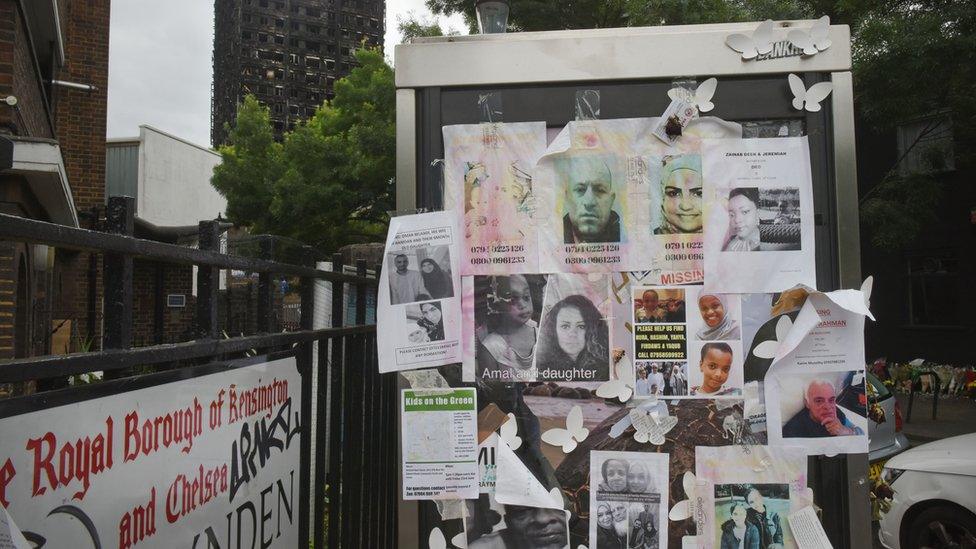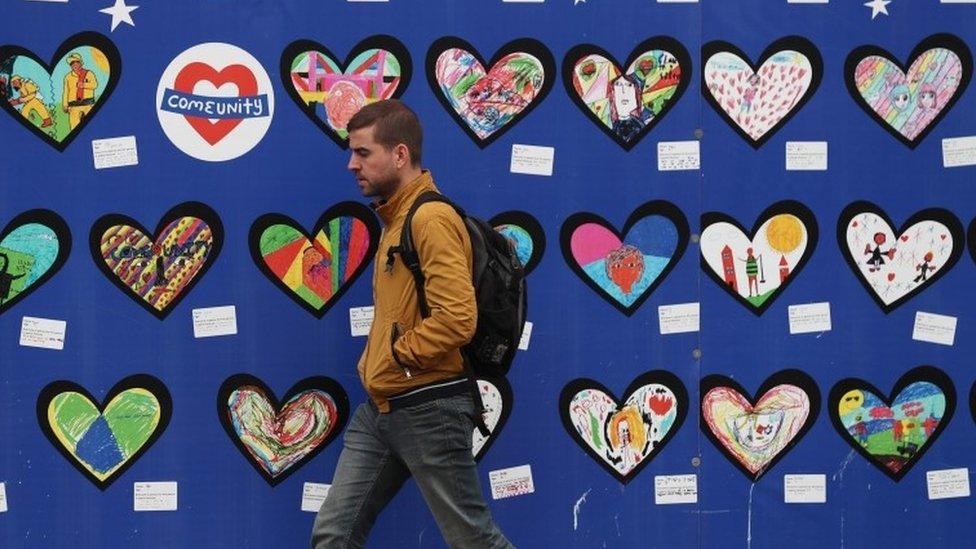Grenfell inquiry: Refurbishment 'turned tower into death trap'
- Published

A refurbishment overseen by Kensington Council turned Grenfell Tower into a "death trap", a public inquiry into last year's fire has heard.
Danny Friedman, representing some of the survivors, said none of those behind the work had accepted any responsibility for their part yet.
His colleague, Stephanie Barwise, said sub-contractors' silence was "inhumane" and painful for bereaved families.
The firms said they would not respond fully until seeing all the evidence.
Ms Barwise accused the firms of putting lives at risk by refusing to say whether changes to the building had been in breach of regulations.
At the hearing in central London, she named several sub-contractors who worked on parts of the refit, including CEP (bought and fabricated Reynobond panels), Harley (facades) and Studio E (architects), and claimed the main contractor, Rydon, was being "disingenuous" about its involvement.
"Despite their words of condolence to the victims, these corporates have no desire to assist this inquiry even though [it] could save lives in the immediate future," she said.
"The corporate silence deprives the families of the degree of resolution and understanding to which they are entitled and has only served to increase their pain and uncertainty."
In its submission, Rydon, the main contractor for the refurbishment between 2014 and 2016, said the inquiry would have to decide whether the industry generally understood whether cladding systems of the type specified at Grenfell Tower could be a significant fire risk.
It did not say whether its refurbishment had breached regulations, and instead questioned some of the expert evidence presented so far.
'Calm rage'
The company also suggested it would play little part in the first phase of the inquiry, which is looking at the immediate causes of the fire.
The inquiry into the fire in west London, which caused 72 deaths, is at the start of a fact-finding stage.
Earlier, over seven days, it heard bereaved families commemorate those who had lost their lives in moving tributes.
Grenfell Tower was a death trap, says survivors' lawyer
Mr Friedman said the people who escaped owed their lives primarily to chance rather than risk assessment and contingency planning.
He said his clients had come to the inquiry in a "calm rage".
Kensington Council had instigated and overseen a refurbishment of the tower block "in such a way as to render it a death trap", Mr Friedman said.
The council and the Tenant Management Organisation (TMO) used public funds, paid to professionals, contractors and sub-contractors, "none of whom have yet accepted any responsibility for their part in what happened", he added.
"Residents - some of the people commemorated last fortnight, and some of the people sitting here today - told them this could happen. But they were fobbed off.
"Certainly not treated as equals; and denied access to the information that they could have used to save themselves; or to save others."
Sam Stein, also representing the bereaved and survivors, said it was the decision of Kensington Council, the TMO and its contractor to try to refurbish the tower "on the cheap" that caused the devastation.
The inquiry is expected to hear from Kensington Council and the TMO on Wednesday.
'Trauma'
Of the firefighting response, he said there were instances of deep gratitude for firefighters but warned "solace" in their heroism was not a route to learning lessons.
"The response failed to realise quickly enough that this was a fire that could not be fought and required an evacuation that could not be delayed," he added.
On Monday, an expert report was submitted by Dr Barbara Lane which found that the Fire Brigade's policy to tell people to stay in their homes had "effectively failed" barely half an hour after the fire started at 01.26 BST on 14 June.
A change in policy recommending residents leave was not made until 02:47.
Mr Friedman went on to ask how these people were left so exposed to "such trauma and death".

Ms Barwise said the fire, which started as a kitchen fire, should have remained so.
To become a disaster of this scale suggested failures at every level of design and construction of the refurbishment, she said.
"Of the six commonly recognised layers of protection against fire - namely prevention, detection, evacuation, suppression, compartmentation and the resistance of the structure to the fire - at Grenfell Tower, five of those layers failed.
"That the structure survived is testament to its original solid concrete, virtually incombustible construction."
In a statement made to the inquiry and published online, external, the London Fire Brigade (LFB) said crews faced terrible dilemmas in the burning building.
The speed and spread of fire posed an "unprecedented set of challenges" as nothing of its kind had been seen in the UK, it said.
Stay-put advice was suitable for Grenfell Tower when it was originally built, as fire should have been contained in one flat, the statement said.
However, it was "less clear" whether subsequent maintenance programmes and refurbishments undermined the integrity of the original design and construction principles from a fire safety perspective.
Pete Weatherby, a lawyer for the bereaved and survivors, said the LFB's statement was "completely lacking" in certain areas.
He told the hearing it did not have "any hints that the LFB accepted that their operation on that night went wrong or that the events expose significant strategic, tactical and policy failures".
The LFB is due to give oral evidence on Thursday.
In other developments:
PSB UK, a company which installed a smoke ventilation system in the block in April, said a fault had not been fixed two days before the fire and no maintenance contract was put in place after installation. The system was designed to clear smoke from individual floors of the tower during a fire
Imran Khan, another lawyer representing the bereaved and survivors, tells the inquiry chairman that the role played by race, religion and social class in the tragedy should be examined
The Metropolitan Police said the forensic investigation inside Grenfell Tower had finished and the site would cease being a crime scene in July or August

Day-by-day: the inquiry so far
